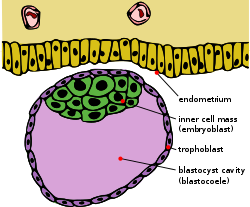
Trophoblast

Trophoblasts (from Greek trephein: to feed, and blastos: germinator) are cells forming the outer layer of a blastocyst, which provide nutrients to the embryo and develop into a large part of the placenta. They are formed during the first stage of pregnancy and are the first cells to differentiate from the fertilized egg. This layer of trophoblasts is also collectively referred to as 'the trophoblast', or, after gastrulation, the trophectoderm, as it is then contiguous with the ectoderm of the embryo.Blastodermic vesicle of Vespertilio murinus.Section through embryonic disk of Vespertilio murinus.Transverse section of a chorionic villus.Scheme of placental circulation.The initial stages of human embryogenesis Trophoblasts (from Greek trephein: to feed, and blastos: germinator) are cells forming the outer layer of a blastocyst, which provide nutrients to the embryo and develop into a large part of the placenta. They are formed during the first stage of pregnancy and are the first cells to differentiate from the fertilized egg. This layer of trophoblasts is also collectively referred to as 'the trophoblast', or, after gastrulation, the trophectoderm, as it is then contiguous with the ectoderm of the embryo.
